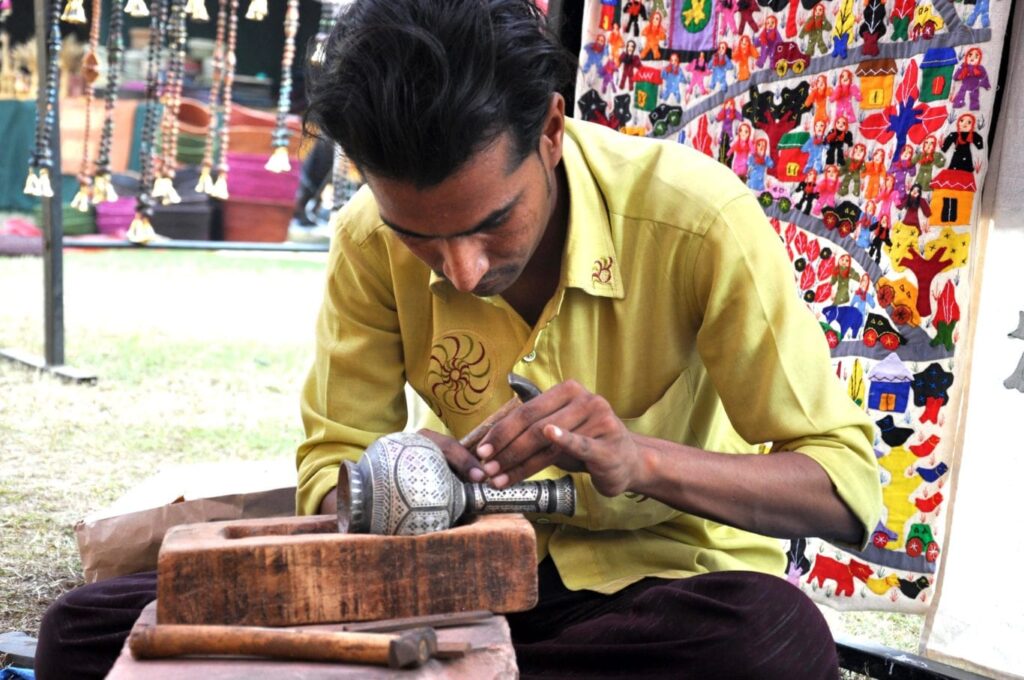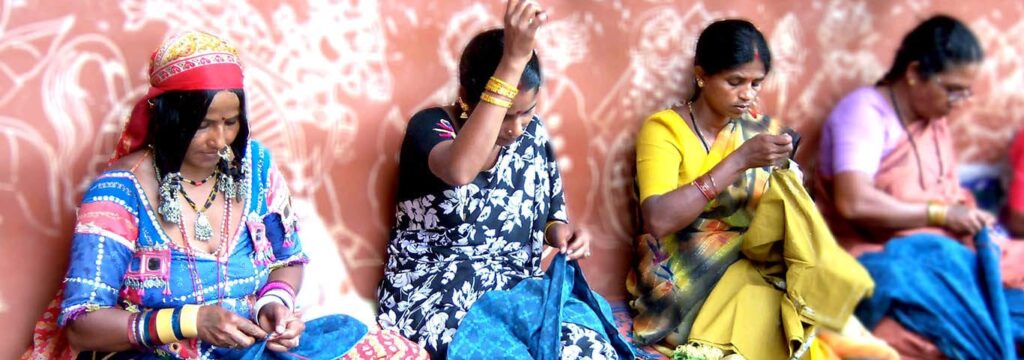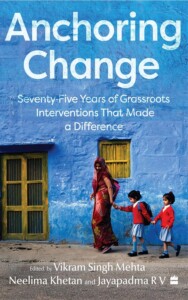Forty years ago, a few women friends who sat talking about why the skill sets and knowledge systems of craftspeople—India’s unique asset in an increasingly industrialized and monocultural world—were being marginalized. Artisanal products had been reduced to cheap tourist bric-a-brac and gift items, their makers regarded as unlettered and redundant. These shared concerns, interspersed with personal memories and laughter, were the genesis of Dastkar.
Dastkar’s strength is that it was created out of these varied life experiences and perspectives, rather than being the singular vision of one individual. The result was an integrated holistic strategy, incorporating our varied viewpoints, and the needs and potential of the producers themselves. The Indian craft and handloom sector is the second-largest source of employment after agriculture, and as long as millions of Indians remain dependent on handcraft for a livelihood, they will need support to keep their place in an increasingly professional and demanding marketplace.
Dastkar has grown organically with the craft communities that are its heart and motivating core. Starting with fourteen crafts groups, we work today with 750-plus artisan communities and over one lakh craft families in every corner of the country, organising, training, professionalising them; adapting and re-designing traditional craft techniques into contemporary products; helping craftspeople hone skills, materials, and production systems and bringing them to the market.
Dastkar craftspeople are now entrepreneurs in their own right, procuring and producing bulk orders, exporting, dealing with retailers directly, owning their own retail outlets, sourcing fabric from each other, developing their own linkages, skills and products on international fashion ramps and trade shows. As a result of Dastkar’s work, incomes are earned, houses are built, villages redesigned, children educated, fed and clothed, and there is sanitation, medicare, and housing. Most significant is the human growth – the entrepreneurs created, self-esteem built, hope generated, cultural identities preserved, creativity brought forth, thousands of women in control of their lives, the skills and creativity of their hands channelled into empowerment and earning.
Crafts remain a story of skilled but unsung, anonymous hands, their voices silent in public forums, their needs ignored in policy and plans, their tools and traditions seldom upgraded by new technology, their products absent in the burgeoning urban malls. They work in the fields as casual labour, unaware that if they were to replicate their old pieces, they could be wage earners. Most craftspeople are the last to benefit from their own traditional skills. This is the paradox that Dastkar seeks to address.

Dastkar means ‘one who works with his hands’ – it is the craftsperson rather than the craft that is the focus of our work. Helping develop skills and products is the catalyst and entry point for the economic and social development of the craftspeople and communities as diverse as the Vankars in Kutch, bead makers from Banaras, and reclusive, burkha-clad women in Lucknow. Brahmin Madhubani painters as well as tribal adivasis come from Bihar to participate in the Dastkar Bazaars and workshops, wide-eyed at the unfamiliar city scene. So do Bodo women from the north-east, mustachioed regurs (leatherworkers) from Rajasthan, kalamkari artists from Machhlipatnam and Kalahasti, victims of insurgency in Kashmir, displaced agricultural labour in Ranthambhore, isolated sheep-herders from the foothills of snow-bound Ladakh, and others.
Dastkar workshops and training help develop both the product and the producer’s skills, and the Bazaars help them understand and learn about the market. The Dastkar Shop and online website, run on a non-profit basis, is a lifeline for several thousand craftspeople – sustaining incomes and livelihoods, as is the permanent Gali-e-Khas at the Dastkar Nature Bazaar.
It was clear at the start that for crafts to survive craftspeople needed to be helped to enter the market directly themselves. Very few commercial retailers, and not even the Government Handicrafts Development Corporations, were willing to invest the time, human resources, and money required to turn a traditional craft into a viable mainstream commodity. One needed a non-profit organisation like Dastkar, without short-term imperatives or narrow sales margins, to act as a bridge between the craftsperson and consumer – guiding craftspeople in design, product development, skills training, and capacity building, and ushering them into the metro market at their own pace.
Forty years later, the success of Dastkar projects like SEWA Lucknow, Berozgar Mahila Kalyan Samiti, Kalaraksha, Ranthambhore, Sandur Kushal Kala Kendra, URMUL, Anwesha, DISHA, Nai Kiran, and many, many more, proves that we were right. Chikan, Lambani and Kutchi embroidery, woven tussar, hand-block printing, tribal jewellery, shibori and pattu weaving, and handmade juthis, are out there on the street, on the fashion ramp, on Page 3, and all over town – their presence there facilitated by Dastkar interventions and marketing, the artisan groups now sustainable.

Ironically, bazaars and exhibitions were not part of Dastkar’s original intent. When we began helping craftspeople develop their skills, we thought that if the product was right a buyer would automatically appear. We had no idea of the invisible wall that separated craftspeople from customers. This led to the first Dastkar Bazaar, with craftspeople coming to the Bazaars in Delhi, Bombay, Bangalore, Calcutta – all the metro cities – selling their own products, interacting directly with customers.
There is a curious paradox, that while both government and CSR schemes are willing to fund projects creating rural employment and vocational training centres abound for carpet weaving, tailoring, embroidery, wood and metal craft, and so on – there is seldom money available for marketing and promoting the finished products. As a result, micro success stories are not converted into macro international block blusters.
Crafts are not just part of our aesthetic and culture, they are the bread of life for millions of craftspeople. Ironically, while figures show that sales of craft, both domestic and export, have doubled or tripled over the last decades, we are simultaneously losing 10 per cent of our craftspeople every ten years. Another important point to remember is that craft is not one sector – it is a multiplicity of skills, communities, traditions, needs.
Dastkar Bazaar became the inspiration for Dilli Haat and similar spaces all over India. They are an opportunity to highlight not only crafts products and skills, but the problems and potential of the sector. The second advantage is the ability to attract a wide cross-section of buyers, including those who would not normally buy craft, and breaking the false perception that handcraft is ‘exclusive’; meant only for ‘elite’ rich customers. Most importantly, the Bazaar is a learning place. Craftspeople realise the value of their own products, but also the importance of quality, functionality, and finish. Learnings are also about packaging, presentation, and display. Craftspeople interact directly with consumers, learning about tastes, trends, and colour preferences. The Bazaar is a good place to test-market products, and discover what moves and what does not, and learn how to reinvent designs and products, while simultaneously maintaining their identity and USP in mainstream markets.
Today we see many young craftspeople recognising the inherent value of their ancestral trades. This reaffirms Dastkar’s strong belief that the continuing existence of an extraordinary diversity of craft traditions and skilled producers is one of India’s great strengths, as it searches for its own identity in a world that is increasingly uniform and technological. But this goldmine needs excavation, as well as assistance, and investment to profit from its ore. Craft, as everything, must move with the times, and we must partner with and give social and economic value to its makers.











